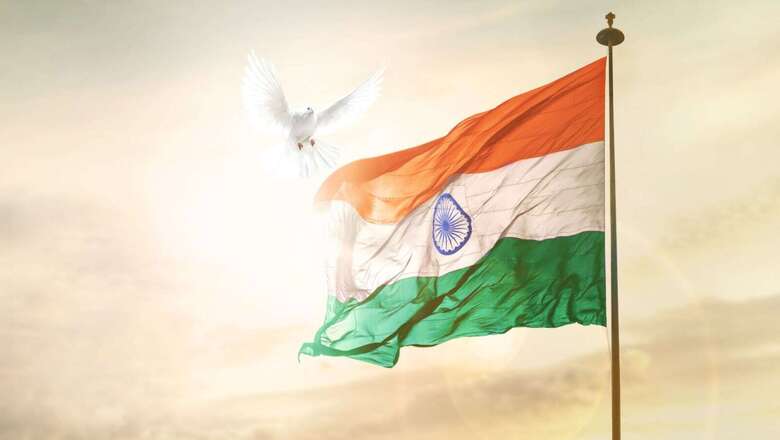
views
On the occasion of the 75th Independence day, celebrated today, let us take a look at the events after the partition of India-Pakistan-Bangladesh which helped in shaping the India we see today.
British India was divided into smaller provinces and princely states. The former was directly under the control of the British government while several large and small states were ruled by princes, and were known as princely states, who enjoyed some form of control over their internal affairs as long as they accepted British supremacy. There were around 565 princely states at the time of independence.
The British government had said the states were free to join either India or Pakistan or remain independent. This decision was left to the people and the princely rulers of these states. This, however, was a problem when trying to build a united India both geographically and politically.
The rulers of Travancore, Bhopal, and Hyderabad had announced that the state had decided on independence.
In most of these princely states, governments were run in a non-democratic manner and the rulers were unwilling to give up their democratic rights to their populations.
Other cities including Lahore, Amritsar, and Kolkata became divided into ‘communal zones’. Muslims would avoid going into an area where the majority were Hindus or Sikhs lived or vice versa. The partition led to a division of properties, liabilities, and assets, a political, and administrative division.
What Did Govt Do?
The interim government took a firm stance against the possible division of India into small principalities of different sizes. The Muslims opposed the Indian National Congress (INC) and were of the opinion that states should be free to adopt any course they liked. Jawaharlal Nehru was appointed as India?s first prime minister. He served the position from August 15, 1947 up till January 26, 1950.
Sardar Patel, who was India’s deputy prime minister and home minister during this time, played a historic role in negotiating with the rulers of princely states and bringing many of them to form the Indian Union. There were 26 small states in today’s Odisha. Gujarat had 14 big states, and 119 small states, and several administrations. The list goes on. The government had to bring them together.
Agreement between states and government
The rulers of most of the states had signed a document called the ‘Instrument of Accession’ which meant that their state agreed to become a part of the Union of India. Accession of the princely states of Junagadh, Hyderabad, Kashmir, and Manipur, however, proved more difficult than the rest. The issue of Junagarh was resolved after the people voted they wanted to join the India union.
In the case of Hyderabad, which was the largest of the princely states, its ruler entered into a Standstill Agreement with India in November 1947 for a year while negotiations with the Indian government were going on. In the meantime, the peasantry in the Telangana region, which were victims of Nizam’s oppressive rule, rose against him. After several protests and fights, the Nizam surrendered that led to Hyderabad’s accession to India.
For Manipur, the Maharaja of the state, Bodhachandra Singh, signed the Instrument of Accession with the Indian government with the assurance that the internal autonomy of Manipur would be maintained. Later, under the pressure of public opinion, the Maharaja held elections in Manipur in June 1948 and the state became a constitutional monarchy. Thus Manipur was the first part of India to hold an election based on a universal adult franchise.
Re-organisation of states
Following the signing of the ‘Instrument of Accession? by the princely states, the challenge was now to draw the internal boundaries of the Indian states. This included not just administrative divisions but also linguistic and cultural divisions. Our leaders felt carving out states on the basis of language might lead to disruption and disintegration and is likely to draw attention away from other social and economic challenges that the country faced. Hence, the central leadership decided to postpone matters.
Protests, however, began in the Telugu-speaking areas of the old Madras province, which included present-day Tamil Nadu, parts of Andhra Pradesh, Kerala, and Karnataka. The Vishalandhra movement demanding a separate Andhra, wanted that the Telugu-speaking areas be separated from the Madras province. Eventually, the prime minister announced the formation of a separate Andhra state in December 1952.
Read| Brain Teaser: Can You Answer These Basic Questions on Indian Independence?
The central government later formed a States Reorganisation Commission in 1953 to look into the question of redrawing the boundaries of states. In its report, the commission said the boundaries of the state should reflect the boundaries of different languages. On the basis of this report, the States Reorganisation Act was passed in 1956. This led to the creation of 14 states and six union territories. The linguistic re-organization also gave some uniform basis to the drawing of state boundaries and did not lead to the disintegration of the country, as many had feared earlier. Rather, it strengthened national unity while accepting diversity.
What Was Need to Unite States
After the partition, the immediate challenge of the government was to shape a nation that was united despite its diversity. Indians speak different languages and have different cultures and religions. The task was to unite them without changing their background, language, or culture.
There was a challenge to establishing democracy as well. Another challenge was to ensure the development and well-being of society as a whole. The central govt now had to evolve effective policies for economic development and eradication of poverty.
To learn about other topics taught in school, explained by News18, here is a list of other Classes With News18: Queries Related to Chapters on Elections | Sex Versus Gender | Cryptocurrencies | Economy & Banks | How to Become President of India | Post Independence Struggle | How India Adopted Its Flag | Formation of States & United India |
Read the Latest News and Breaking News here














Comments
0 comment